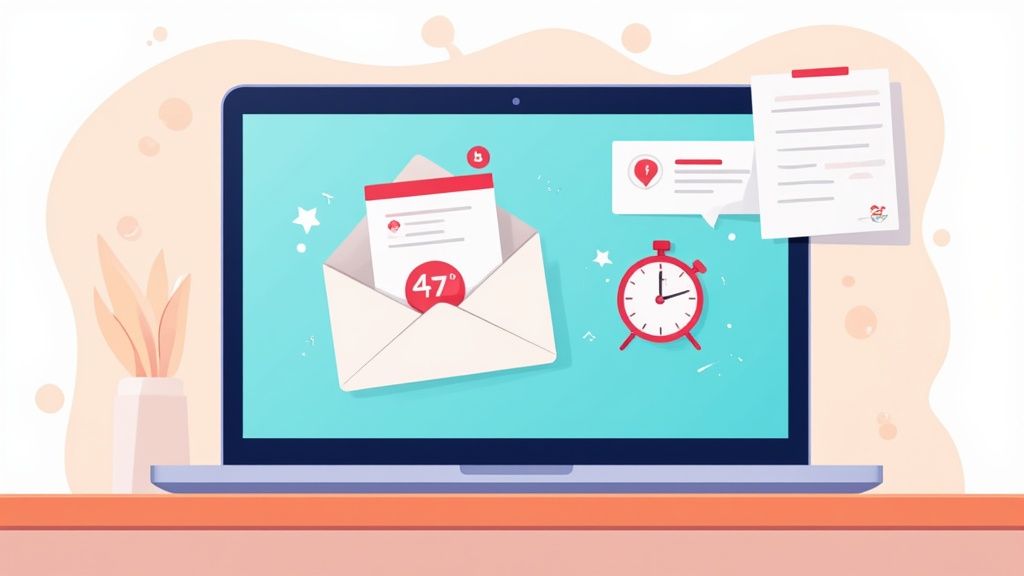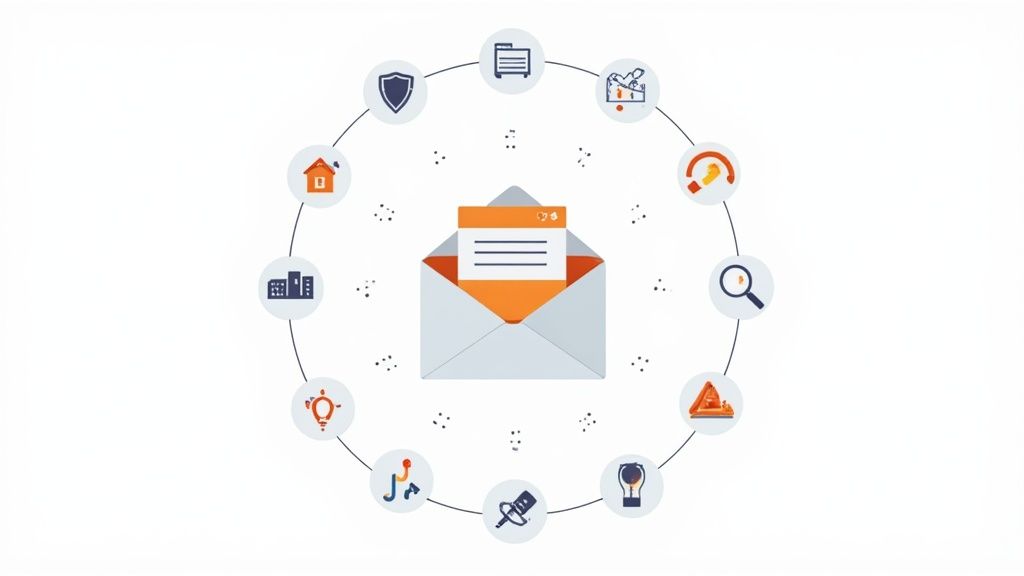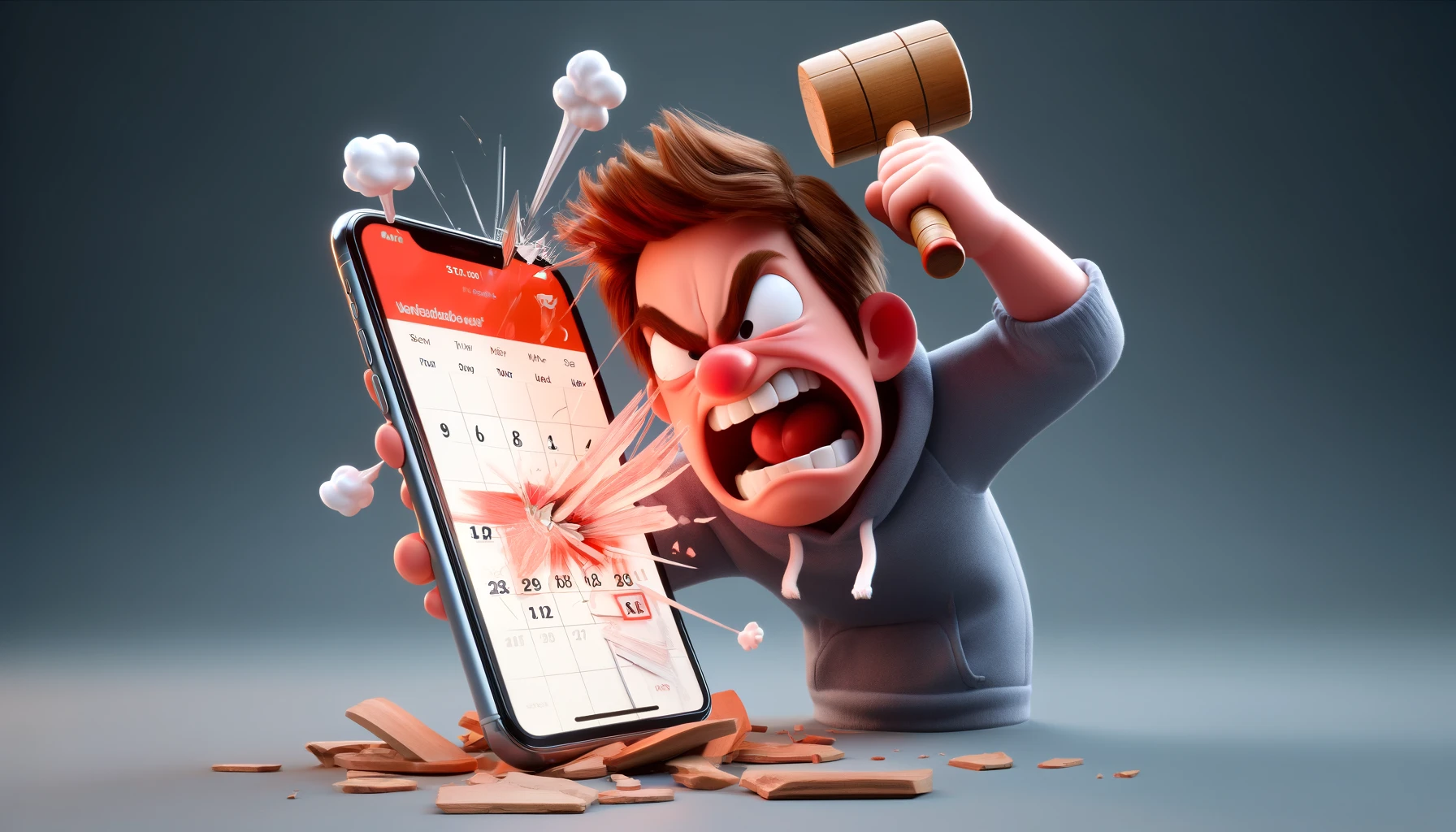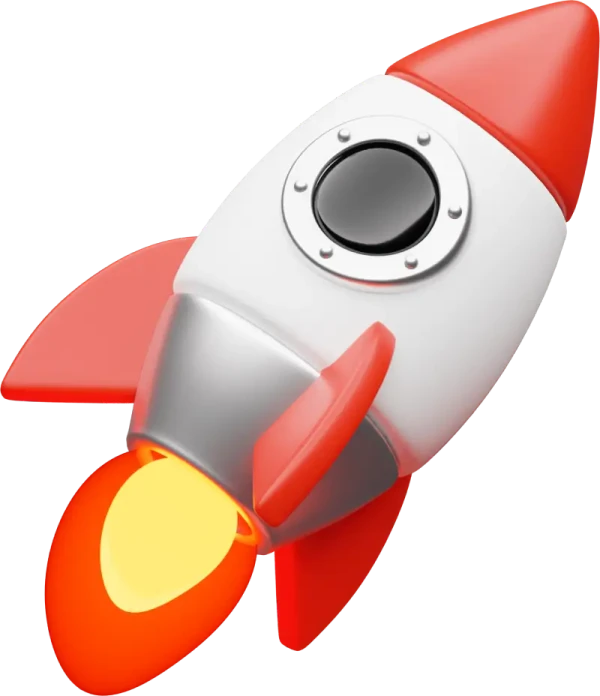In a world of constant digital noise, you might be surprised to learn that a simple email holds incredible power for your event's success. Think of email event reminders as your direct, reliable channel for connecting with attendees, fighting no-shows, and building genuine excitement.
This isn't just about sending a last-minute link; it's a core part of modern email marketing for events.
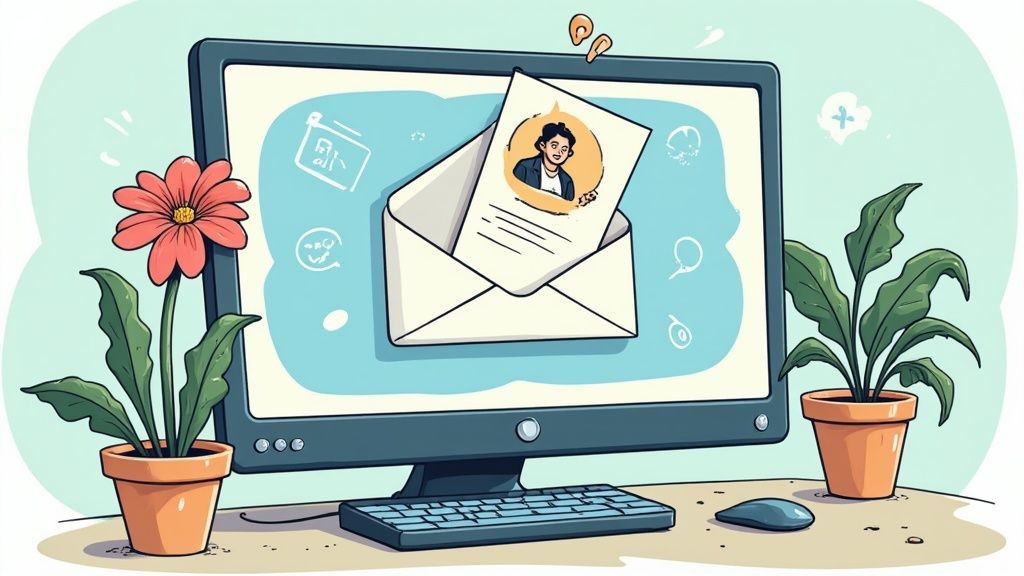
Why Email Still Dominates Event Marketing
While flashy social media campaigns grab headlines, email remains the undisputed champ of direct communication for events. It’s the digital equivalent of a personal nudge - a way to cut through the clutter and deliver essential info right to your registrants.
Honestly, a well-executed reminder strategy is often the difference between a forgotten registration and an engaged participant.
I saw this firsthand with a major tech conference. They recently saw a 30% drop in no-shows after they completely revamped their email reminder sequence. They moved from a single, generic email to a series of targeted messages that built up excitement and gave crystal-clear instructions. It was a perfect case study on the immense value of a thoughtful approach.
The Power of a Direct Connection
Unlike social media feeds controlled by fickle algorithms, an email lands in a personal, private space. This direct line to your audience is priceless for making sure they receive critical updates.
By sending a reminder, you’re doing more than just sharing logistics. You’re reinforcing the value of your event and showing attendees you’re invested in their experience. This simple act builds trust and makes people feel more committed to showing up.
The numbers don't lie. In 2023, the average email open rate hovered around 20%, and a whopping 77% of B2B buyers prefer email for professional contact. This is especially true for webinars and conferences.
The right strategy can turn a simple notification into a powerful engagement tool. If you're curious, Snov.io published some great email marketing statistics that really show how you can shape your event strategy with this data.
More Than Just a Reminder
A strategic email sequence is your chance to do so much more than just state the date and time. It’s your opportunity to:
- Build Anticipation: Drop a sneak peek of a speaker, reveal a surprise special guest, or link to a pre-event networking group.
- Reduce Friction: Give people clear directions, parking info, or a one-click link to the virtual session. Make it easy for them.
- Boost Engagement: Encourage attendees to use an event hashtag or download a companion app before the event even starts.
Effectively, these emails become a core part of the overall event experience.
The benefits of putting a real system in place for your email reminders are clear and measurable.
Key Benefits of Strategic Email Reminders
| Benefit | Impact on Event | Example Metric |
|---|---|---|
| Reduced No-Shows | Maximizes attendance and ensures a fuller, more vibrant event. | 30% decrease in attendee drop-off rate. |
| Increased Engagement | Gets attendees excited and interacting before the event begins. | 20% increase in pre-event hashtag usage. |
| Improved Attendee Experience | Provides clarity and reduces pre-event stress for participants. | 15% reduction in support queries about logistics. |
| Reinforced Event Value | Keeps the event top-of-mind and reminds people why they signed up. | Higher open rates on "day-of" and "final reminder" emails. |
Ultimately, a thoughtful reminder strategy isn't an afterthought - it's a foundational piece of a successful event that respects your attendees' time and commitment.
Crafting Reminders People Actually Want to Read
The best event reminders don't just state facts; they get people genuinely excited to show up. So, let's move past the theory and get practical. I'm going to break down the anatomy of an email that actually gets opened, read, and acted upon. It’s really a mix of a solid subject line, easy-to-scan content, and a helpful, human tone.
Your main goal is to respect your attendee's time while subtly reinforcing why they signed up in the first place. Think about it: with a staggering 376.4 billion emails expected to be sent daily by 2025, just getting noticed is a huge win.
The good news? People actually want relevant, timely information. Transactional emails like reminders often see fantastic engagement, with some analyses showing open rates hitting 47.86%. This tells us your audience is ready and waiting, as long as you deliver the goods.
Start with a Subject Line That Cuts Through the Noise
Your subject line is everything. It's the first - and sometimes only - thing people see. It needs to be clear and compelling without feeling like cheap clickbait. A little personalization here can make a world of difference in your open rates.
And I don't just mean sticking their first name in there. A great subject line sets clear expectations and creates a sense of timeliness. If you want to dive deeper, there are some great email subject line best practices that can help you stand out.
From my experience, these approaches work consistently well:
- Benefit-Driven: "Get Your Questions Answered: Live Q&A Tomorrow"
- Urgency-Focused: "Your Link for Tomorrow's Webinar is Inside"
- Direct & Simple: "Reminder: Event Name is this Thursday"
Clarity is king. Your attendee should know exactly what the email is about before they even click.
Structure the Email for Maximum Scannability
Once they've opened your email, you have mere seconds to give them what they need. Don't bury the important stuff. Put the most critical details right at the top where they're impossible to miss.
Pro Tip: I always recommend structuring the key event details in a visually distinct block. Use bold text, maybe some simple icons, or even a basic table to lay out the "who, what, when, where." This lets attendees find what they need in a single glance.
This simple layout shows you respect their busy schedule and immediately delivers value. The rest of the email is your chance to build some hype or share other useful info. A boring corporate reminder just lists facts. But a reminder for a music festival? That could include a link to a curated playlist to get people in the mood.
This is how you turn a basic notification into a valuable piece of content.
It’s also incredibly important to make it easy for people to confirm they're coming. You can check out our guide on how to create an RSVP link to embed this functionality right in your emails. It’s a small step that can give you a much more accurate headcount.
At a minimum, the body of your email should quickly answer these core questions:
- What is the event? Re-state the event name clearly.
- When is it? Give the full date and time, and always, always include the time zone.
- Where is it? For a virtual event, this has to be a direct, clickable link. For an in-person one, a full address with a map link is non-negotiable.
- What do I do next? This is your call-to-action. Think "Add to Calendar" or "View the Full Agenda."
When you focus on clarity and scannability, your reminders become a genuinely helpful service instead of just another email clogging up an inbox.
Finding Your Perfect Reminder Cadence
Let's be honest, the timing of your event reminders is just as critical as what you put inside them. A perfectly crafted email sent at the wrong time is just a wasted effort. The real goal is to create a schedule that keeps your event top-of-mind without just adding to the inbox clutter. This means moving beyond a rigid, one-size-fits-all template and thinking about what makes sense for your specific event.
When you're figuring out your reminder cadence, you have to remember you're up against the challenge of inbox fatigue. You need your messages to pop. A quick, one-hour webinar needs a completely different touch than a multi-day conference people have paid to attend.
This is a classic and effective flow I've seen work time and time again for a standard virtual event. It’s a simple, three-step cadence.
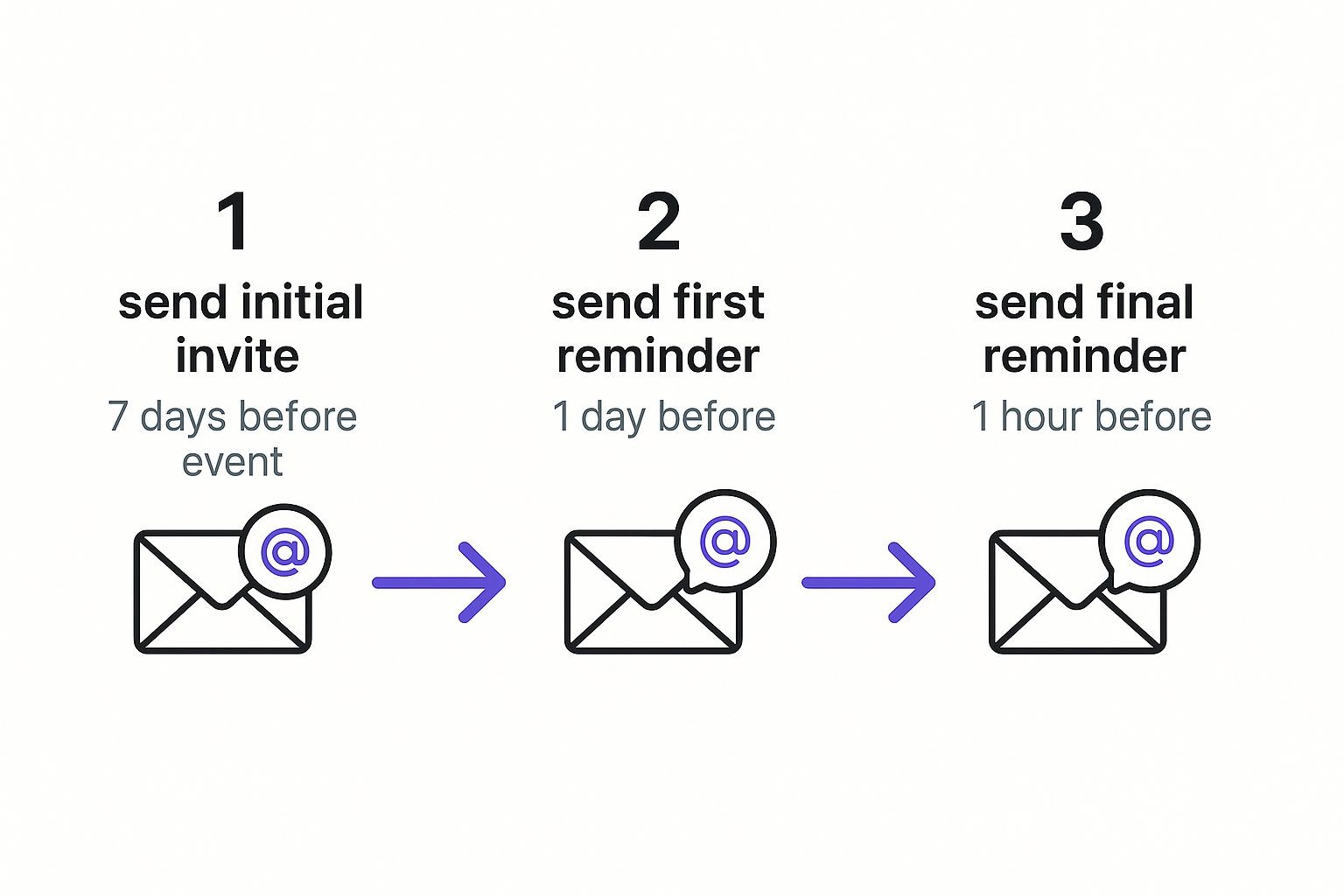
This simple one week, one day, and one hour model is a fantastic foundation. It builds just enough anticipation while also covering the last-minute logistical needs that can make or break attendance.
Why This Timing Works
Each email in your sequence has a very specific job. This isn't just about sending random pings; it's a strategic progression designed to guide your attendee all the way from registration to actually showing up.
- The "One Week Out" Email: Think of this as your anticipation-builder. Its job is to get people excited and re-confirm the event's value. This is the perfect spot to share a sneak peek of the agenda, spotlight a keynote speaker, or link to some pre-event reading.
- The "Day Before" Email: This one is all about logistics. The goal here is simple: remove any friction that could stop someone from attending. This email absolutely must have the essentials: the final time (with the time zone clearly stated!), a direct link to the virtual venue, and any login details they might need.
- The "Event Starting Soon" Email: This is the final nudge, and it's absolutely critical. I usually send this 15 to 60 minutes before kickoff. Its only purpose is to get people to click the link and join. Keep it super brief, with the access link right at the top.
Fine-Tuning Your Schedule for Real-World Events
While that "one-week, one-day, one-hour" model is a great starting point, you’ll need to adjust it based on your event's complexity and your audience.
For a major conference that attendees paid for, you might want to start your reminders two weeks out to help them plan. But for a casual, free webinar? A much tighter sequence - maybe just a day before and an hour before - is probably more effective.
The time of day you send these emails matters, too. I’ve found that sending emails around 11 AM on a Tuesday or Thursday often gets the best engagement. It makes sense, as people have settled into their workday. Interestingly, research shows that about 61% of subscribers actually prefer getting promotional emails weekly, which really backs up the value of that "one week out" reminder.
To give you a clearer picture, here’s a sample schedule you could adapt for a typical one-day virtual event.
| Sample Reminder Schedule for a Virtual Event | | :------------------------------------------- | :------------------------------ | :------------------------------------------------------------------------------ | | Timing | Purpose of Email | Key Content to Include | | 1 Week Before | Build anticipation & excitement | Speaker spotlight, agenda sneak peek, link to pre-event community or resources. | | 3 Days Before | Provide logistical details | Full agenda, tech check reminders (e.g., "test your access"), FAQs. | | 24 Hours Before | Final logistics & countdown | Final time with time zone, direct event link, "how to join" instructions. | | 1 Hour Before | The final nudge to join | Super brief message, a big prominent "Join Now" button or link. | | 15 Minutes After Start | Catch latecomers | "We're live! It's not too late to join us." with the direct link. |
This gives you a bit more granularity and includes that "latecomer" email, which can be surprisingly effective at boosting your final attendance numbers.
At the end of the day, your own data is your most powerful tool. Start A/B testing your send times. Send one batch of reminders at 10 AM and another at 2 PM. Look at the open and click-through rates. Over time, you’ll build a data-backed cadence that feels perfectly timed and drives the best results for your audience.
Automating Your Workflow to Save Your Sanity
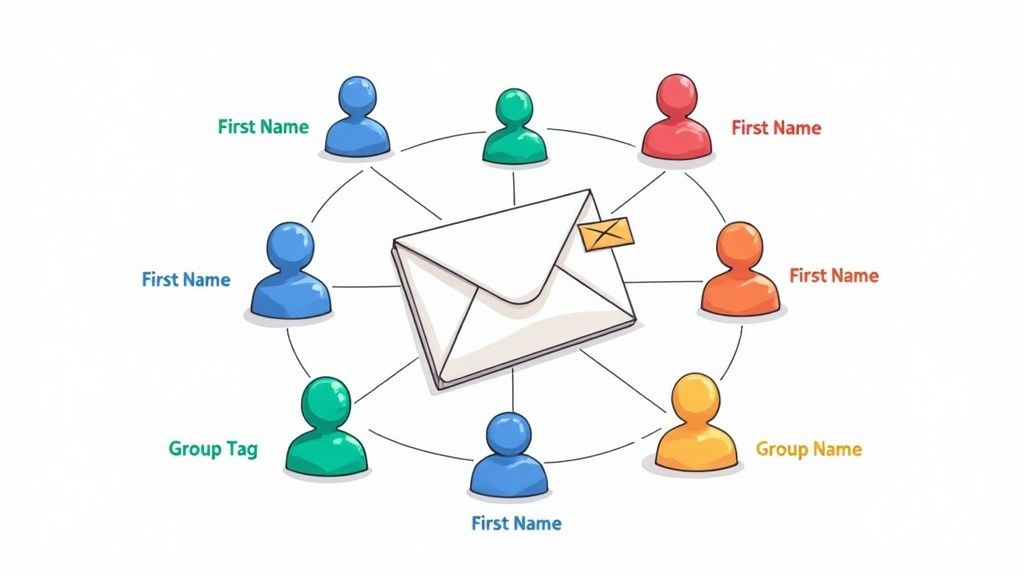
Let’s be honest: manually sending every single email event reminder is more than just tedious - it’s a direct path to making mistakes. Automation isn't just a nice-to-have; it's your best friend for getting precious time back in your day while still delivering a flawless experience for your attendees.
This isn't about getting tangled up in complex code. It's about setting up a reliable "set it and forget it" engine that works for you.
Most modern email platforms, like Mailchimp or ActiveCampaign, let you build simple but powerful automation workflows. The most common trigger is beautifully straightforward: when someone registers for your event, they're automatically dropped into your reminder sequence. This one step ensures nobody slips through the cracks and that your communication stays consistent.
But that's just the beginning. This is where you can graduate from basic reminders to creating truly personalized journeys.
Building Smart Segments for Better Engagement
Automation is a game-changer when it comes to relevance. It lets you slice and dice your audience based on their registration details. Imagine crafting different reminder paths for different types of attendees, all running silently in the background without you or your team lifting a finger.
For instance, you could have a workflow that automatically sorts people:
- VIP Ticket Holders get an exclusive reminder with a sneak peek of the VIP lounge or a special message from a keynote speaker.
- General Admission attendees receive a reminder focused on the practical stuff, like the main stage schedule and parking info.
- Virtual-Only Attendees are sent a reminder that includes a tech-check guide and the direct link to the streaming platform.
This kind of targeted communication makes every attendee feel seen and valued, which does wonders for boosting their excitement and making sure they actually show up. Your email event reminders go from being a generic blast to a personalized concierge service.
The real magic of automation is its power to kill human error and keep your brand consistent, even at scale. Every single person gets the right message at the right time, every time, without you ever having to hit "send."
Triggering Actions Beyond an Email
A truly effective automation workflow can do a lot more than just send messages. Depending on the tools you're using, you can set up triggers that update your internal systems or ping your team about important activities. It keeps everyone on the same page.
Think about these practical scenarios:
- Tagging Registrants: Automatically tag contacts in your CRM based on the specific event they signed up for. This makes all your future marketing efforts that much smarter.
- Internal Alerts: Set up an automatic Slack notification for your sales team the moment a high-value prospect registers for your webinar.
- Post-Event Follow-up: Trigger an entirely new automated sequence once the event is over to send out thank-you notes, feedback surveys, and links to session recordings.
By automating the whole reminder workflow, you build a system that nurtures your attendees from the second they register until long after the event wraps up. This frees you up to focus on what you're best at: creating an event experience people won't forget.
Advanced Tactics for High-Impact Reminders
Once you have your automated reminder sequence humming along, it’s time to level up. Basic reminders get the job done, sure, but high-impact reminders create an experience. They build genuine excitement and keep people engaged.
Let's dig into a few advanced tactics I've seen work wonders for making email event reminders truly stand out.
One of the most powerful psychological nudges you can use is a dynamic countdown timer. I’m not talking about a static GIF. These are live timers that actually tick down in real-time every single time a recipient opens the email.
Watching the hours and minutes disappear creates a real sense of urgency. It’s a simple trick that transforms a mundane reminder into a can't-miss countdown.
Build Hype with Social Proof
Beyond just the logistics, your reminders are a golden opportunity to show attendees why they should be excited. This is where social proof comes in. Instead of just listing the date and time, build some serious hype around the people and content you've lined up.
I’ve had great success with a few specific approaches:
- Spotlight a keynote speaker with a compelling quote or, even better, a short video clip.
- Showcase notable companies or brands that are attending to highlight the networking potential.
- Share testimonials or killer stats from last year's event to build credibility and a healthy dose of FOMO (fear of missing out).
This shifts the whole feeling of the email from a simple notification to a value-packed preview, reminding people exactly why they signed up. These tactics fit perfectly into a broader strategy; you can find more great event promotion ideas in our other guides to see how this all fits together.
Make Your Reminders Interactive
Who said emails have to be a one-way street? You can get your audience involved long before the event even kicks off by adding interactive elements right into your reminders. It’s a small change that can seriously boost engagement and make people feel like they’re part of the event from day one.
Expert Tip: I love embedding a simple poll or a link to a Q&A submission form in the "one week out" reminder. Ask attendees what they're most excited to learn. You’ll not only make your emails more engaging, but you’ll also gather fantastic user-generated content you can use during the event.
It's a win-win. You get valuable insights into what your audience actually cares about, and they feel heard.
Master the Post-Event Follow-Up
The event isn't over when the last session ends. The post-event follow-up is probably the most overlooked - and most valuable - touchpoint in your entire communication plan. This is your chance to cement the experience, get honest feedback, and build a bridge to whatever comes next.
A solid post-event email isn't complicated. It just needs to include a few key things:
- A genuine thank-you message for attending.
- Links to session recordings, slides, or other resources.
- A request for feedback with a short, dead-simple survey.
- A teaser or an early-bird offer for your next event.
This final email closes the loop perfectly. You provide lasting value and turn a one-off event into the beginning of a real relationship, making them eager to see what you do next.
Even with a solid plan, a few tricky questions always pop up when you're setting up your reminder emails. Let's tackle some of the most common ones I hear so you can get your sequence out the door with confidence.
How Many Reminders Is Too Many?
This is the big one, right? You want to be helpful, not a pest.
From my experience, a sequence of three reminder emails usually hits that sweet spot for most events. It keeps you top-of-mind without flooding their inbox.
A classic, effective cadence looks something like this:
- One week out: This is your "get excited" reminder.
- One day before: Time to focus on logistics.
- One hour before: The final "we're starting soon!" nudge.
Of course, this isn't set in stone. A huge multi-day conference might need an extra touchpoint, while a casual weekly webinar could probably get by with just two. Feel it out, but three is a great starting point.
What's the Best Way to Handle Different Time Zones?
Time zone mix-ups are a silent killer of attendance for virtual events. I’ve seen it happen too many times.
The simplest fix is to always state the time zone clearly in your emails (e.g., 2:00 PM EST / 11:00 AM PST). Spell it out so there’s no room for error.
But here’s the pro move: include an "Add to Calendar" link. When an attendee clicks it, the event automatically saves to their calendar in their local time zone. It completely sidesteps the problem.
This small step makes a massive difference for your global audience and shows you're thinking about their experience.
Should I Send Reminders to People Who Haven't Opened Previous Emails?
This is a great question. It feels counterintuitive to keep emailing people who aren't opening, but for event reminders, my advice is: yes, keep sending them.
Think about it - people are busy. An unopened email isn't a "no," it's often just "not right now." Someone might completely ignore your one-week reminder but be desperately searching for the event link an hour before it starts.
The risk of someone missing out because they didn't get that final, crucial email is way higher than the risk of annoying them. They signed up for a reason, after all.
Can I Include an FAQ in a Reminder Email?
Absolutely! Sticking a mini-FAQ in your "day before" or "week before" email is a fantastic idea. It's super scannable and lets you get ahead of the most common questions before they even hit your inbox.
Focus on practical, logistical stuff. Things like:
- Parking directions or transit info for in-person events.
- The official dress code (if there is one).
- How to access the event recording afterward.
- Details on the guest policy.
Answering these things upfront makes you look organized and helps your attendees feel prepared and ready to go.
Ready to create a seamless event experience with automated reminders and powerful Add to Calendar buttons? Add to Calendar PRO provides all the tools you need to boost attendance and save time. Explore our features and start your free trial.
